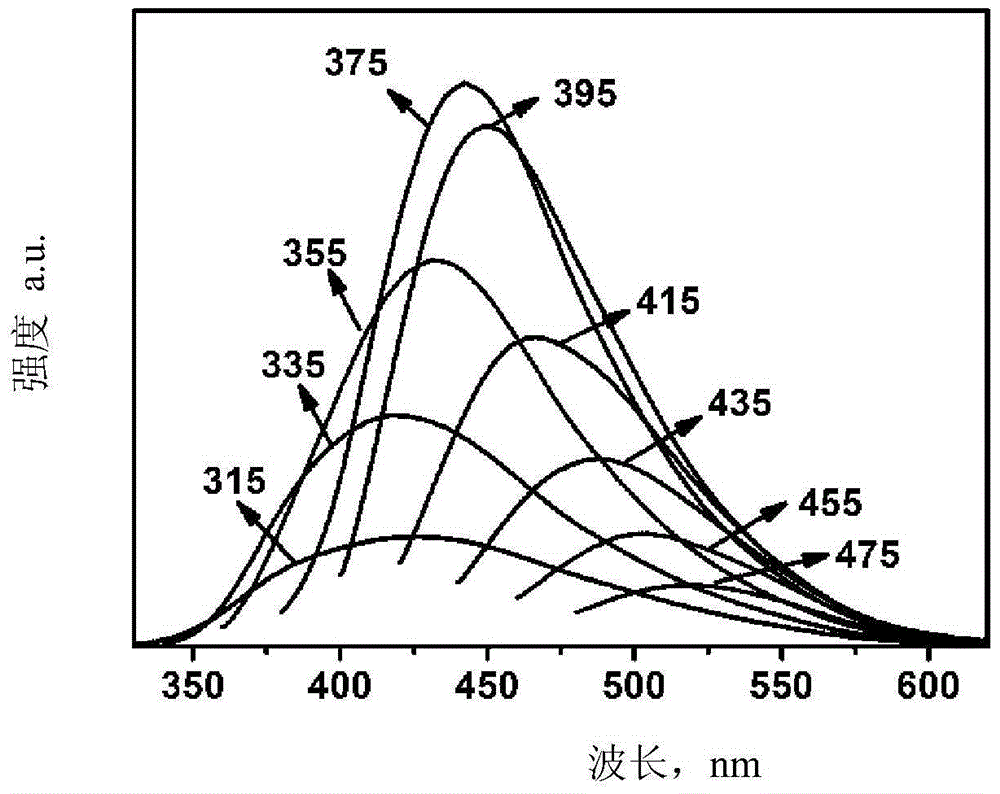Carbon quantum dots with room temperature phosphorescence and delayed fluorescence properties and their synthesis and applications
A technology of carbon quantum dots and delayed fluorescence, which is applied to carbon-containing luminescent materials and their synthesis and application fields, can solve the problems of high price, cumbersome preparation steps, and non-compliance with environmental protection, and achieve high output, increase transition probability, and reduce Effects of nonradiative transitions
- Summary
- Abstract
- Description
- Claims
- Application Information
AI Technical Summary
Problems solved by technology
Method used
Image
Examples
Embodiment 1
[0036] Weigh 8 g of isophorone diisocyanate (IPDI) into a polytetrafluoroethylene mold, place it in a microwave reactor (CEM company, MARS6) at a power of 700 W, and react at 250 ° C for 10 min, cool to obtain a gray solid, take it out and grind it into Powder; add 50ml of ethanol to dissolve to obtain a brown solution, remove insoluble matter by centrifugal filtration at 10000rmp for 30min; dialyze with a 3500Da dialysis bag for 48 hours. The dialyzed solution was dried in a vacuum oven at 60° C. to obtain pure carbon quantum powder (named IPDI-CD), and the yield was as high as 83%.
[0037] The carbon quantum dots obtained in this embodiment are detected, such as Figure 1~4 . figure 1 It is the infrared spectrum of IPDI-CD carbon quantum dots. It can be seen from the figure that at 1700cm -1 Strong peaks appear on the left and right, indicating that carbon quantum dots contain C=0; 3300, 1580cm -1 The stretching vibration peaks of N-H and C=N respectively indicate that t...
Embodiment 2
[0039] Weigh 5g of toluene diisocyanate (TDI) into a polytetrafluoroethylene mold, put it in a microwave reactor, react at 700W, 200°C for 10min, cool to obtain a dark gray solid, take it out and grind it into powder; add 50ml of ethanol to dissolve it to obtain Brown solution, 10000rmp, 30min centrifugal filtration to remove insoluble matter; dialysis with a 3500Da dialysis bag for 48 hours, the solution after dialysis was dried in a vacuum oven at 60°C to obtain pure fluorescent carbon quantum powder (named TDI-CD) . The carbon quantum dots are detected, and the TDI-CD has a uniform size, an average particle diameter of 4.3nm, and a yield of 80%.
Embodiment 3
[0041] Weigh 5g of hexamethylene diisocyanate (HDI) into a polytetrafluoroethylene mold, put it in a microwave reactor, and react at 1000W and 300°C for 30min, cool to obtain a dark gray solid, take it out and grind it into powder; add 50ml of ethanol to dissolve it to obtain Brown solution, 10000rmp, 30min centrifugation to remove insoluble matter; dialysis with 3500Da dialysis bag for 48 hours, the solution after dialysis was dried in a vacuum oven at 60°C to obtain pure fluorescent carbon quantum powder (named HDI-CD) . The detection of carbon quantum dots shows that the size of HDI-CD is uniform, the average particle size is 3.8nm, and the yield is ~83%.
PUM
| Property | Measurement | Unit |
|---|---|---|
| particle size | aaaaa | aaaaa |
Abstract
Description
Claims
Application Information
 Login to View More
Login to View More - R&D
- Intellectual Property
- Life Sciences
- Materials
- Tech Scout
- Unparalleled Data Quality
- Higher Quality Content
- 60% Fewer Hallucinations
Browse by: Latest US Patents, China's latest patents, Technical Efficacy Thesaurus, Application Domain, Technology Topic, Popular Technical Reports.
© 2025 PatSnap. All rights reserved.Legal|Privacy policy|Modern Slavery Act Transparency Statement|Sitemap|About US| Contact US: help@patsnap.com



